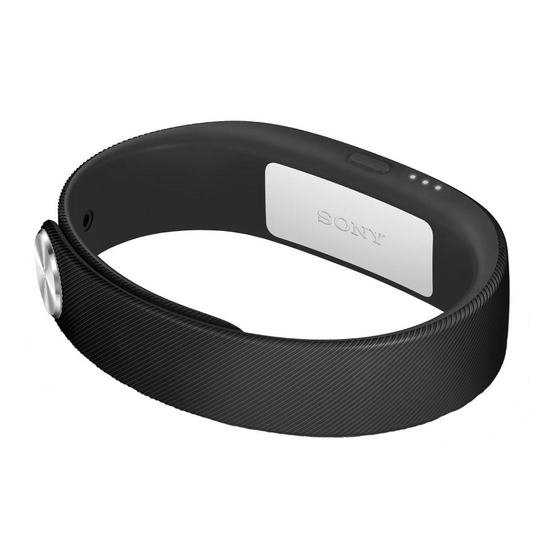
Sony SmartBand SWR10 User Manual
Hide thumbs
Also See for SmartBand SWR10:
- Manual (2 pages) ,
- User manual (18 pages) ,
- Troubleshooting (5 pages)
Table of Contents
Advertisement
Advertisement
Table of Contents

Summary of Contents for Sony SmartBand SWR10
- Page 1 User guide SmartBand SWR10...
-
Page 2: Table Of Contents
Contents Basics.....................3 Introduction..................3 Hardware overview................3 Charging your SmartBand..............3 Assembly...................4 Turning your SmartBand on and off..........5 Setting up your SmartBand............6 Preparing to use your SmartBand.............6 Reconnecting your SmartBand using NFC........7 Day mode and night mode..............7 Resetting your SmartBand..............7 Settings for your SmartBand............8 SmartBand alarm................8 Out-of-range alert notifications............9 Incoming call notifications..............9... -
Page 3: Basics
NFC detection area Charging your SmartBand Before using your SmartBand for the first time, you need to charge it for approximately 30 minutes. Sony chargers are recommended. This is an Internet version of this publication. © Print only for private use. -
Page 4: Charging
To charge your SmartBand Plug one end of the USB cable into the charger or into the USB port of a computer. Plug the other end of the cable into the Micro USB port of your SmartBand. Battery notification light status Notification light A flashes continuously The battery is charging and is not yet fully charged Notification light A is on... -
Page 5: Turning Your Smartband On And Off
Turning your SmartBand on and off To turn on your SmartBand • Press and hold down the power key until your SmartBand vibrates. When turning on your SmartBand for the first time, it automatically enters pairing mode and notification light A flashes until your SmartBand is connected to a device. To turn off your SmartBand •... -
Page 6: Setting Up Your Smartband
Google Play™ and connect to your Android™ device. The Smart Connect application is pre-installed on all Android™ devices from Sony Mobile at purchase. Make sure that you update it to the latest version. -
Page 7: Reconnecting Your Smartband Using Nfc
Reconnecting your SmartBand using NFC If your SmartBand loses connection, for example, when the connected Android™ device goes out of range, you can reconnect the two devices using NFC. To reconnect your SmartBand using NFC Android™ device: Make sure that the NFC function is turned on and that the screen is active and unlocked. -
Page 8: Settings For Your Smartband
Settings for your SmartBand You can view and change settings for your SmartBand from the SmartBand application, which can be accessed under Devices in the Smart Connect application. Enable alarm notifications from Xperia™ devices and set a smart alarm. Turn the out-of-range function on or off. Turn incoming call notifications on or off. -
Page 9: Out-Of-Range Alert Notifications
Smart alarm function uses sleep data from your SmartBand over a time span of 30 minutes to wake you up when you reach a state of light sleep. For example, if you set a smart alarm for 07:00 and your SmartBand is in night mode, it wakes you up sometime between 06:30 and 07:00 when you reach a state of light sleep. -
Page 10: Controlling Applications From Your Smartband
To turn on the messaging notification function From the Home screen of your Android™ device, tap , then find and tap Smart Connect. Tap Devices > SmartBand > SmartBand. Mark the Messaging checkbox. Controlling applications from your SmartBand You can control a selected application on the connected Android™ device using your SmartBand. -
Page 11: Logging Your Activities Using The Lifelog Application
Follow the instructions that appear on the screen and accept the terms and conditions. Create a new account or select to use an existing one. Sony PlayStation® Network accounts can also be used. Follow the instructions that appear on the screen to create a Lifelog account. - Page 12 To log in to the Lifelog application From the Home screen of your Android™ device, tap , then find and tap Lifelog. Follow the instructions that appear on the screen and accept the terms and conditions. Activity boxes overview Shows all logged life bookmarks Shows your sleep hours and define the quality of your sleep based on the information collected Shows the calories you have burned Shows the time you have spent in communication...
-
Page 13: Setting Goals
Show the amount of activity using the chosen unit type Details about your activity Setting goals Set goals for activities in your daily life, for example, the number of steps to take, the distance you want to walk, or the amount of calories you want to burn. To set a goal In the Lifelog application, tap the activity that you want to set a goal for. -
Page 14: Important Information
Important information Using your SmartBand in wet and dusty conditions Your SmartBand is waterproof and dust resistant in compliance with the Ingress Protection (IP) rating IP58, as explained in the table below. This specific IP rating means that your SmartBand is dust resistant and is protected against low pressure water stream as well as against the effects of immersion for 30 minutes in fresh (non-saline) water up to 3 metres deep. -
Page 15: Legal Information
Prior to use, please read the Important information leaflet separately provided. This User guide is published by Sony Mobile Communications AB or its local affiliated company, without any warranty. Improvements and changes to this User guide necessitated by typographical errors, inaccuracies of current information, or improvements to programs and/or equipment, may be made by Sony Mobile Communications AB at any time and without notice. -
Page 16: Declaration Of Conformity
(1) This device may not cause harmful interference, and (2) This device must accept any interference received, including interference that may cause undesired operation. Any change or modification not expressly approved by Sony may void the user's authority to operate the equipment.



